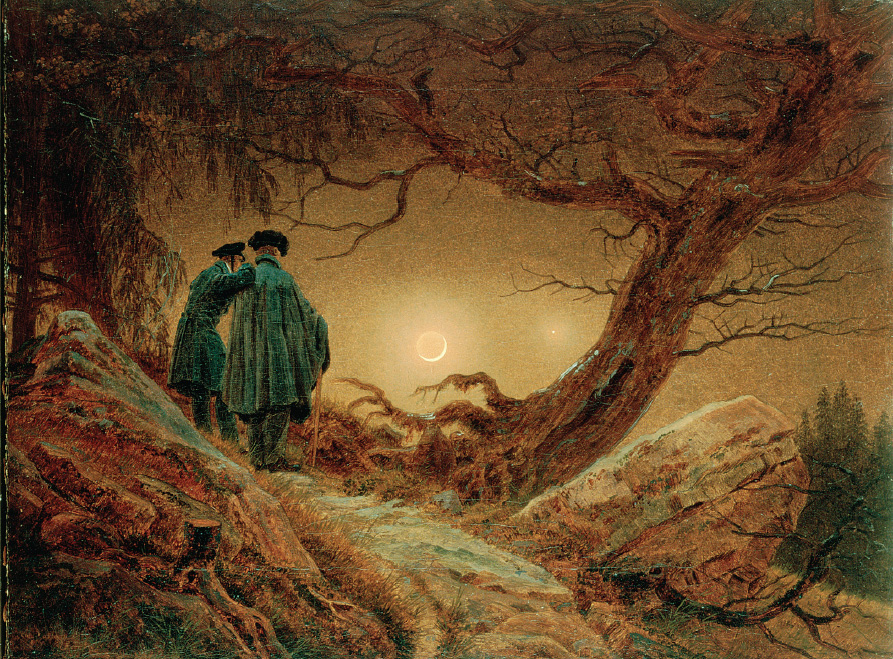A History of Western Society: Printed Page 696
A History of Western Society, Value Edition: Printed Page 702
Literature
Romanticism found its distinctive voice in poetry, as the Enlightenment had in prose. Though romantic poetry had important forerunners in the German “Storm and Stress” movement of the 1770s and 1780s, its first great poets were English: William Blake, William Wordsworth, Samuel Taylor Coleridge, and Sir Walter Scott were all active by 1800, followed shortly by Lord Byron, Percy Bysshe Shelley, and John Keats. (See “Primary Source 21.2: English Romantic Poets.”)
A towering leader of English romanticism, William Wordsworth was deeply influenced by Rousseau and the spirit of the early French Revolution. Wordsworth settled in the rural Lake District of England with his sister, Dorothy, and Samuel Taylor Coleridge (1772–1834). In 1798 Wordsworth and Coleridge published their Lyrical Ballads, which abandoned flowery classical conventions for the language of ordinary speech and endowed simple subjects with the loftiest majesty. Wordsworth believed that all natural things were sacred, and his poetry often expressed a mystical appreciation of nature:
To every natural form, rock, fruit or flower
Even the loose stones that cover the high-way
I gave a moral life, I saw them feel,
Or link’d them to some feeling: the great mass
Lay bedded in a quickening soul, and all
That I beheld, respired with inward meaning.6
Here Wordsworth expressed his love of nature in commonplace forms that a variety of readers could appreciate; this stanza well illustrates his famous conception of poetry as the “spontaneous overflow of powerful feeling [which] takes its origin from emotion recollected in tranquility.”7
In France under Napoleon, classicism remained strong and at first inhibited the growth of romanticism. An early French champion of the new movement, Germaine de Staël (duh STAHL) (1766–1817) urged the French to throw away their worn-out classical models. Her study On Germany (1810) extolled the spontaneity and enthusiasm of German writers and thinkers, and it had a powerful impact on the post-1815 generation in France. (See “Individuals in Society: Germaine de Staël.”) Between 1820 and 1850, the romantic impulse broke through in the poetry and prose of Alphonse de Lamartine, Victor Hugo, and George Sand (pseudonym of the woman writer Armandine-Aurore-Lucile Dudevant). Of these, Victor Hugo (1802–1885) became the most well known.

Son of a Napoleonic general, Hugo achieved an amazing range of rhythm, language, and image in his lyric poetry. His powerful novels exemplified the romantic fascination with fantastic characters, exotic historical settings, and human emotions. The hero of Hugo’s famous The Hunchback of Notre Dame (1831) is the great cathedral’s deformed bell-ringer, a “human gargoyle” overlooking the teeming life of fifteenth-century Paris. Renouncing his early conservatism, Hugo equated freedom in literature with liberty in politics and society. His political evolution was thus exactly the opposite of Wordsworth’s, in whom youthful radicalism gave way to middle-aged caution. As the contrast between the two artists suggests, romanticism was compatible with many political beliefs.
In central and eastern Europe, literary romanticism and early nationalism often reinforced one another. Well-educated romantics championed their own people’s histories, cultures, and unique greatness. Like modern anthropologists, they studied peasant life and transcribed the folk songs, tales, and proverbs that the cosmopolitan Enlightenment had disdained. The brothers Jacob and Wilhelm Grimm were particularly successful at rescuing German fairy tales from oblivion. (See “Primary Source 21.3: The Brothers Grimm, Children’s Stories and Household Tales.) In the Slavic lands, romantics played a decisive role in converting spoken peasant languages into modern written languages. In the vast Austrian, Russian, and Ottoman Empires, with their many ethnic minorities, the combination of romanticism and nationalism was particularly potent. Ethnic groups dreaming of independence could find revolutionary inspiration in romantic visions of a historic national destiny.